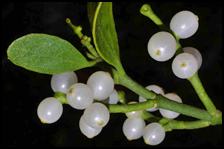You entered European Mistletoe, the more common name is...

Mistletoe
SCIENTIFIC NAME:(Phoradendron serotinum L., Phoradendron flavescens L. )
Mistletoe grows attached to trees and shrubs, from which it derives some or all of its sustenance. This evergreen is woody with many branches. The stem is fatter at the nodes where opposite, leathery, yellowish-green leaves grow. The pale yellowish green flowers grow in jointed spikes from March to May, and from September to November; they develop into mucilaginous, white berries.
Common Names:
American Mistletoe, Birdlime, Golden Bough, Devil’s Fuge, European Mistletoe

Uses:
The tea is used as a wash for inflammation, itching, and swelling of the feet, toes, or fingers caused by mild frostbite as well as leg ulcers. A compress is used for varicose veins. This plant raises the blood pressure and increases uterine contractions. Said to be used for epilepsy, convulsions, hysteria, heart problems, and pore circulation. However, there are many other plants, which are safer and just as good and in some cases better than Mistletoe.Applications:
Wash:
Steep the leaves, and berries to make a wash.
Warnings:
This plant is dangerous and SHOULD NOT BE USED without medical supervision if at all.
With any herb, there is the risk of an allergic reaction. Small children and pregnant women should use additional caution when considering the use of herbal remedies.





